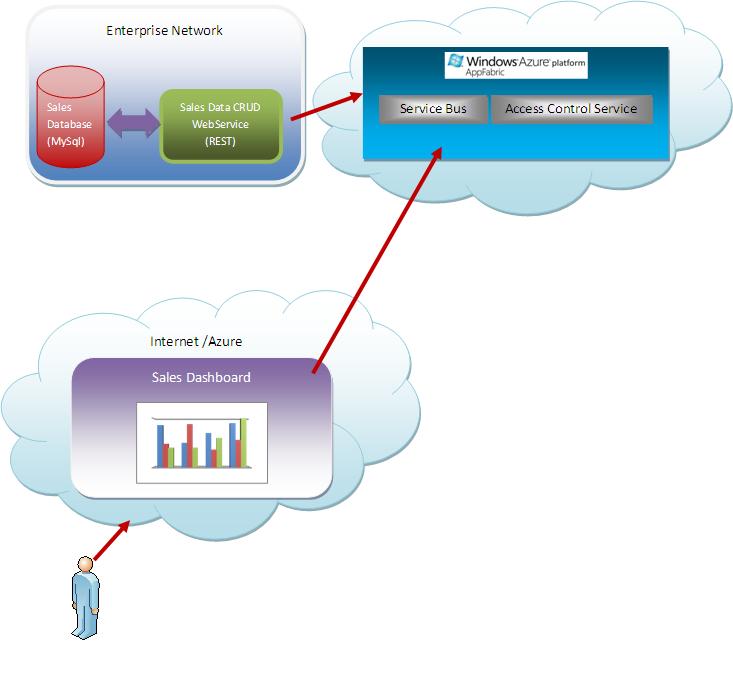|
Demo - Sales Dashboard using AppFabric SDK for Java
|
|
|
|
|
|
|
|
Introduction
|
|
The Sales Dashboard application demonstrates how a
traveling sales person can create and update orders
on a corporate Sales application running within the
enterprise datacenter. The sales person is able to
view and update the company's sales data despite the
fact that (s)he is not able to otherwise access the
corporate network. The sample demonstrates how the
Access Control Service and Service Bus can be used
to provide secure access to a service running inside
the corporate network from an external network. The
application is developed in Java and MySQL.
Either apache or IIS Web Server can be used.
Web server can be used Sun GlassFish or Apache Tomcat or JBoss. |
|
|

|
|
|
|
|
Architecture
|
|
The following diagram illustrates the technical
design of the Sales Dashboard application. In this
scenario, the Java client application is hosted on
the Internet and RESTful web services are inside the
enterprise network. |
|
|

|
|
Low Level Architecture of Sales Dashboard Scenario
|
|
|
|
Various components shown in architecture diagram are described below.
|
|
|
|
Sales Dashboard Web Service
|
|
|
|
Sales Dashboard web service provides RESTful web services for basic operations like Create, Read, Update, Delete (CRUD) over the Sales Database.
|
|
|
|
The application validates the ACS token received through request header in order to allow or deny further processing of request and response accordingly. For the validation ACS token validation functionality exposed by SDK is used.
|
|
|
|
The Sales Dashboard REST web services are exposed outside enterprise network using Service Bus endpoint. This is achieved by using an intermediate service, so no changes to the Sales Dashboard service are required.
|
|
|
|
Intermediate Polling Service
|
|
|
|
Intermediate Polling Service is a console application. It continuously polls on the specified Message Buffer for incoming messages. The first time, it internally creates a Message Buffer and then keeps on polling for incoming messages on it, using Service Bus section of the SDK. On receiving a new message, message contents are extracted and an HTTP REST request is formed and forwarded to the configured URL passed in the message (In Sales Dashboard application it is 'Sales Dashboard web service URL'). The response returned by web service is then written to another Message Buffer which is specified by the client, in its request message.
|
|
|
|
|
/*
* Intermediate service that helps the client send messages to the service
* using Message buffers and sends the response back
* @param credentials Required for authentication
* @param serviceMessageBuffer Name of the message buffer at
* which the service is going to listen for requests
* */
public void startPolling(Credentials credentials, String serviceMessageBuffer )
throws Exception{
MessageBuffer msgBuffer = new MessageBuffer(credentials, solutionName);
MessageBufferPolicy msgBufferPolicyObj = new MessageBufferPolicy
(authorization,transportProtection, expiresAfter, maxMessageCount);
//Create message buffer
msgBuffer.createMessageBuffer(serviceMessageBuffer, msgBufferPolicyObj);
//Poll for requests
while(true)
{
//Retrieve message from message buffer
String str = msgBuffer.retrieveMessage(serviceMessageBuffer);
if(!StringUtil.IsNullOrEmpty(str)){
//Parse the message
ServiceMessage record = parseMessage(str);
//Forward request to service
response = fireHttpRequest(record);
//Send response to client
msgBuffer.sendMessage(messageBufferName, response);
}
}
}
|
|
|
|
|
Client Application
|
|
|
|
Client application communicates with ACS, using SDK, in order to obtain token, that is used while requesting exposed Sales Dashboard RESTful web services. Similarly, client application uses the SDK to communicate with the Sales Dashboard web service using the intermediate service.
|
|
|
|
To make any request to the web service, the client application will call a function, sendRequest(), with the target URI. The sendRequest function creates the Message Buffer using the SessionId as Message Buffer name in case it is not already created. It writes a message to the Message Buffer "salesOp" and waits for response on the Message Buffer {clientSessionId}. The sendRequest method, returns the response to the client application.
|
|
|
|
|
public PollingServiceResponse sendRequest(String url,
HttpVerbs httpVerb, String sessionId, HashMap<String, String> headers,
String body) throws DotNetServicesException {
MessageBuffer msgBuffer;
PollingServiceResponse responseObj = null;
MessageBuffer msgBuffer = new MessageBuffer(credentials, solutionName);
// To send message to message buffer
String messageStr = xmlForPollingService(url, httpVerb,sessionId,
headers, body, false);
msgBuffer.sendMessage(messageBufferName, messageStr.toString());
//reading the response. Message buffer with name sessionId was
//created while logging in
String retrievedMessage = msgBuffer.retrieveMessage(sessionId);
//Extract and return response code and response String
responseObj = parseResponse(retrievedMessage);
return responseObj;
}
|
|
|
|